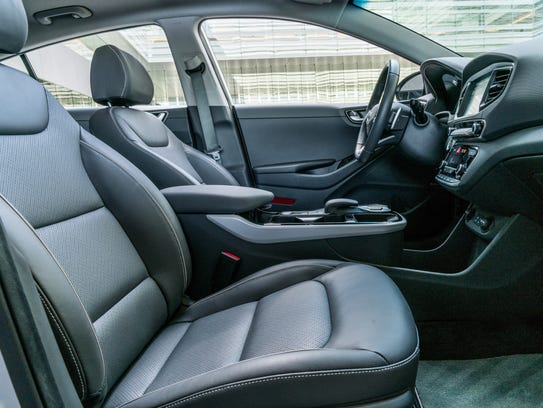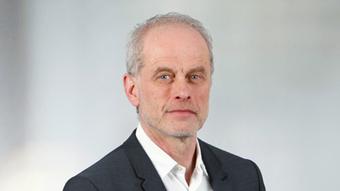Autoplay
Show Thumbnails
Show Captions
Last SlideNext Slide
2017 Hyundai Ioniq Electric Vehicle (Photo: Hyundai)
How big a limitation is a battery range of 124 miles in an electric car? Not crippling, but meaningful, I learned in a week driving Hyundai's ★★★ 2017 Ioniq compact electric car.
The Ioniq Electric is one of three new alternate fuel Hyundais that share the same hatchback body. There's also a conventional hybrid. A plug-in hybrid goes on sale late this year.
The three are Hyundai's bid to boost its image for producing high-tech, environmentally friendly vehicles. Hyundai's built hybrids before, but the Ioniq is the first with a unique body style. There's no mistaking it for anything else in Hyundai's lineup.
Read more:
Study paints perilous future for automakers competing to make driverless cars
Many pathways to the promised land of self-driving cars
The Ioniq electric's range would have made it a leader a year ago, but the Chevrolet Bolt changed the game when it hit the road with a 238-mile range late last year. Electric vehicles that hadn't even gone on sale yet suddenly seemed a wee bit antiquated, including the Ioniq.
The Ioniq Electric competes with electric vehicles (EVs) like the BMW i3, Chevrolet Bolt, Fiat 500e, Mitsubishi i-MiEV and Nissan Leaf. It will also compete with the Tesla 3 and 2017 VW e-Golf when they go on sale.
Behind the Wheel
2018 Hyundai Ioniq Electric Limited
Front-wheel-drive, five-passenger compact electric car
Price as tested: $36,000 (excluding destination charge)
Rating: ★★★ (Out of four stars)
Reasons to buy: Electric power, features, price
Shortcomings: Range, rear visibility, fit & finish

2017 Hyundai Ioniq Electric Vehicle (Photo: Hyundai)
How much?
Prices for the Ioniq electric start at $29,500. It has an EPA-rated range of 124 miles on a charge, and takes about four and a quarter hours to recharge from a 220- or 240-volt outlet. The hybrid, which has smaller batteries and a gasoline engine, starts at $22,200.
I tested a well-equipped Ioniq electric that stickered at $36,000. It included several features EVs often omit, including a power sunroof, adaptive cruise control and memory for the driver's settings. Those goodies add weight or draw electricity. That reduces range, and many automakers have — wrongly, I think — decided EV buyers will trade comfort and convenience for a few extra miles between charges. My test car also had leather upholstery, Bluetooth, Apple CarPlay, Android Auto, blind spot alert; automatic emergency braking, lane departure alert, wireless phone charging, navigation, voice recognition and a touch screen.
The Ioniq's price is competitive with other EVs in terms of features and driving experience. A Chevy Bolt with similar features would sticker for $40,905, and the Bolt doesn't offer blind spot alert, sunroof or memory at any price.
Competitive base prices (excluding destination charges)
(Front-wheel-drive models)
Hyundai Ioniq Electric Limited: $32,500
BMW i3 EV 60 Ah: $42,400
Chevrolet Bolt Premier: $40,905
Fiat 500e: $32,995
Mitsubishi i-MiEv: $2,995
Nissan Leaf SL: 36,790
2017 Volkswagen e-Golf: Not available
Source: Autotrader
Range matters
The kicker, of course is that the EPA rates the Bolt at 238 miles on a charge, nearly double the Ioniq. That's a huge benefit, and it's much of the difference between the Bolt's trophy as 2017 North American Car of the Year and the Ioniq's rating of a good, but not great three stars.
I used the Ioniq for all my driving for a week. I've got a short commute, and the Ioniq handled my regular driving with ease, but I couldn't manage the 140-mile round trip to my brother's house for his birthday. Fortunately, my niece wanted to see the Detroit Zoo's new sloth enclosure, a mile from my house, so there was no damage to family harmony. Well, no more than on any birthday.
Anybody who owns an EV or plug-in hybrid should get a 220v charger. They reduce charging time drastically, allowing you to drive on electricity more frequently and with less downtime.
The Bolt is the BEV range king, and that makes it the car to beat, despite the Ioniq's better menu of features.
Tesla's upcoming 3 aims to roughly match the Bolt's range and cost, but there are no independent tests of it yet.
Competitive EPA fuel economy ratings
(Front-wheel-drive models)
Hyundai Ioniq Electric Limited: 19 mpg city/28 highway/22 combined. Regular gasoline.
BMW i3 EV 60 Ah: 129/106/118. Range 81 miles.
Chevrolet Bolt Premier: 128/110/119. Range 238 miles.
Fiat 500e: 121/103/112. Range 84 miles
Mitsubishi i-MiEv: 126/99/112. Range 59 miles
Nissan Leaf SL: 124/101/112. Range 107 miles
2017 Volkswagen e-Golf: 126/111/119. Range 125 miles
Source: www.fueleconomy.gov
Riding and driving
My Ioniq's interior was attractive but restrained, with grey leather upholstery, a rubbery soft-touch material on the dash and doors and simple controls. A unique feature lets you conserve electricity by directing climate control only to the driver seat when the car has no passengers.
The passenger compartment is the roomiest in its class. The front seat has plenty of room and storage cubbies. The rear seat is not generous, but no worse than many conventional compacts.
The cargo area is also best in class. The liftover height to load objects is high because of the big battery pack under its floor.
The Ioniq performs well. The electric motor produces an unimpressive 118 hp, but its 215 pound-feet of torque translates to deceptively strong, smooth acceleration. The steering is predictable and steady but doesn't deliver much feedback.
Paddles on the steering wheel allow the driver to set different levels of regenerative braking to extend range and slow the car when you lift off the accelerator pedal. The three settings are very different, but none of them provide enough regen for the max-efficiency "one-pedal driving" the Chevy Bolt offers.
Specifications as tested
Engine: Electric motor
Power: 118 hp; 2215 lb-ft of torque
Transmission: 1-speed automatic
Wheelbase: 106.3 inches
Length: 176.0 inches
Width: 71.7 inches
Height: 51.7 inches
Curb Weight: 3,164 lbs.
Where assembled: Ulsan, Korea
The downside
Several of my test car's features could use refinement. There was a large, uneven gap in the trim around a small parcel shelf at the base of the center console. It was an obvious and surprising oversight in a high-profile new car like the Ioniq.
Rear visibility is hampered by a narrow rear window and the car's Appel CarPlay shifted my iPhone out of iPod mode several times, switching from my music library to Beats 1 on Apple Radio, a service I never use.
The climate control system automatically resets to "eco" setting when you start the Ioniq. That reduces the air conditioner's electric draw, but cooling suffered on hot, muggy days. I ended up using the normal setting most of the time.
The verdict
The Ioniq follows Hyundai's tried and true formula of offering a lot of features for its price. Its availability with popular features like a sun roof should force other automakers to improve their electric cars.
The 124-mile range probably isn't quite enough for most drivers to make the Ioniq their only car, but it will fill a lot of people's needs a lot of the time.
A few easy tweaks to improve steering feel and response, and closer attention to interior fit and finish will make the Ioniq electric an even better choice.
Key features on vehicle tested
Standard equipment: Antilock brakes, stability control; front side air bags; curtain air bags; driver knee air bag; 16-in alloy wheels; power mirrors, locks and doors; memory for driver settings; power driver seat; leather upholstery; push button start; automatic climate control; auto dimming rear view mirror; HD radio; SiriusXM trial membership; Apple CarPlay; Android Auto; Bluetooth compatible; voice recognition; tire repair kit.
Options: Power sunroof; automatic emergency braking; adaptive cruise control; lane departure alert; HID headlights with dynamic bending light function; navigation; 8-in. touch screen; Infinity audio; eight speakers; wireless device charging; LED interior lights.
Contact Mark Phelan: mmphelan@freepress.com or 313-222-6731. Follow him on Twitter @mark_phelan.
Read or Share this story: http://on.freep.com/2uTLZIU
Source:
2017 Hyundai Ioniq electric car is long on features, short on range










 New Accord coming by the end of the year.
New Accord coming by the end of the year.  Thomson Reuters
Thomson Reuters

 © TheStreet Apple Said to Be Working on Electric Vehicle Batteries
© TheStreet Apple Said to Be Working on Electric Vehicle Batteries  75,000 Bonus Reward Points + $0 Annual Fee 1st Yr - ANZ Rewards Black Ad
75,000 Bonus Reward Points + $0 Annual Fee 1st Yr - ANZ Rewards Black Ad 



